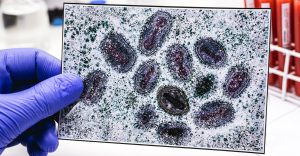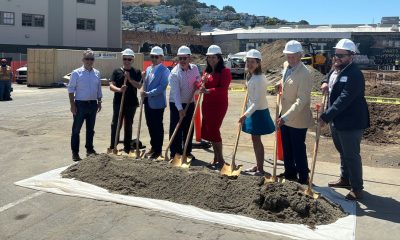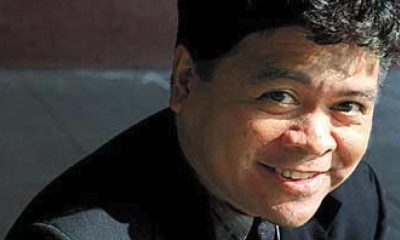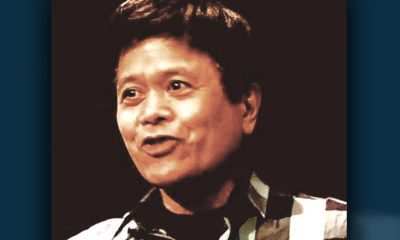Technology
Even Apple Loyalists Taking Their Time on Apple Watch

In this April 10, 2015, file photo, a customer tries on an Apple Watch at an Apple Store in Hong Kong. (AP Photo/Kin Cheung, File)
BARBARA ORTUTAY, AP Technology Writer
NEW YORK (AP) — For all those who hailed the iPhone as the “Jesus Phone” in 2007, the Apple Watch’s arrival has hardly been the second coming.
Sure, it can do many useful, even delightful things, such as showing incoming texts and email, tracking heart rates during exercise or sending digital doodles to friends. But is that enough to spend $350 or more, especially when it requires wearing a watch again while still carrying an iPhone around?
Early Apple Watch owners seem generally happy with it, but Apple’s bigger worry should be those on the sidelines — even hardcore Apple fans, not to mention everybody else — who are waiting to take the plunge.
The wait-and-see attitude is not exactly helping investor sentiment. Apple hasn’t released Apple Watch sales figures, but the company’s quarterly financial report Tuesday suggests that they were lower than many Wall Street analysts expected, though Apple said they exceeded internal projections.
A bigger worry for investors: iPhone sales, which at $31 billion account for more than half of Apple’s business.
IPhone sales are still growing rapidly, but the pace of growth is slowing. Worries about the iPhone’s momentum sent Apple’s stock down nearly 5 percent, knocking about $36 billion off the company’s market capitalization.
Among people holding off on the watch, some say they are waiting for early kinks to be worked out and others, for an “aha moment.”
“It’s been cast as a want, not a need,” said Matt Quick, a Topeka, Kansas, engineer and Apple fan who is holding off on getting one. “I’m kind of waiting to see what next year’s model will bring.”
Patrick Clayton, who has had Mac computers all his life and owns an iPhone and several iPads, returned his Apple Watch after three weeks. The last straw? It nagged the physically active New Yorker to stand up during a six-hour flight.
“Apple is famous for telling us what we need before we need them,” Clayton said. “I thought this would be the case with the watch. But it (just) added something to my life that I didn’t need added.”
That’s not to say the Apple Watch is a bomb. For one, it’s too soon to tell. Expectations are so high that it’s easy to forget, as Apple said, that the watch actually sold better in its first 9 weeks than the iPhone and the iPad did when those came out.
Most analysts and tech reviewers, including The Associated Press, see promise, especially compared with rival smartwatches from Samsung and others. Wristly, a research company created to study the watch, found that early buyers are overwhelmingly satisfied, more so than with the original iPad and iPhone.
And of the more than a dozen early Apple Watch owners interviewed by the AP by phone, email or in person, most of them love their watch. After all, early adopters of new technologies tend to understand that what they’re getting isn’t perfect.
“I’d recommend it to people with an open mind,” said Dennis Falkenstein of Danville, California. He said the watch gets him “everything I want” such as local temperature, or the current time in Japan, where many of his business clients are.
But even so, there’s a long wish list, including smarter apps. Apple is already addressing some of this with a software update this fall. Falkenstein would also like to see the battery life improve from the 18 hours that’s currently promised.
Apple has run television commercials showing the watch in everyday life, and it has devoted tables at its retail stores for people to try one on and learn more.
Connected wirelessly to an iPhone, the Apple Watch isn’t meant to replace the phone, but rather provide tidbits of information readily while the phone is in a pocket or purse. There’s no keyboard, so searches and messages are done by voice dictation or the selection of a canned response. You can also send doodles and emoji.
David Lubarsky, a Fairfield, Connecticut, photographer, loves that he can get “basic information, quick” and avoid staring at Facebook on the phone all day. It lets him see texts, emails, calendar appointments and baseball scores.
But he gets frustrated when using it to pay for coffee at Starbucks.
“Your wrist doesn’t necessarily twist to the right position to the scanner so it’s pretty awkward,” he said.
Apple Watch also doesn’t always provide the right information at the right time. The watch version of one transit app offers bus schedules for your saved locations — even if they are far away — rather than the stops closest to you at the moment, as the phone app does. As for message notifications, it’s great when it’s from someone you want to hear from — but annoying when it’s not.
It’ll take time for apps to anticipate what users need most.
Apps will get better when Apple updates the watch’s software this fall to permit more “native” apps — those that aren’t just extensions of phone apps. Some apps could even work without the phone nearby, including games, audio recorders and tools that analyze golf swings.
Apple also needs to ensure that the watch gets the types of essential “killer apps” that propelled the iPhone into an extension of ourselves. For now, it’s sometimes easier to just pull out the phone, and there’s no app you absolutely need the watch for. With phones, you now have maps, cameras and other essentials.
It might be hard to remember, but the first iPhone in 2007 was just a little more than a phone. Apps from outside companies didn’t come until Apple launched its app store the following year — with just 500 apps. Now, it has more than a million. At first, iPhone apps were dumbed-down versions of websites. Now many apps, such as Instagram, do more than what’s possible over Web browsers.
Apple Watch doesn’t subject owners to ridicule the way Google Glass had, yet it’s still, in essence, a computer on your wrist. Yes, the Apple Watch comes in multiple sizes, materials and bands — 54 configurations in all — and other companies sell additional bands. But the watch isn’t stylish enough for everyone and won’t match every outfit.
The watch could ultimately be more than just a Rolex for the tech-savvy set. But for that to happen, Apple needs to show how the benefits of wearing a watch outweigh the hassles of wearing a watch.
___
AP Technology Writer Brandon Bailey in San Francisco contributed to this report.
Copyright 2015 The Associated Press. All rights reserved. This material may not be published, broadcast, rewritten or redistributed.
Alameda County
OPINION: Argent Materials Oakland CleanTech Community Asset Helps Those In Need
Alameda County Supervisor Lena Tam had this to say about Argent Materials as an Oakland community asset: “Congratulations to Argent Materials and its President and Founder, Bill Crotinger! The company is now fully operational, recycling an impressive 99.99% of concrete and asphalt debris, which helps divert thousands of tons of construction waste from landfills. They are also proud to announce that 50% of their team consists of local hires. In celebration of Thanksgiving, and despite stormy weather last week, the Alameda County Sheriffs, alongside Mr. Crotinger and Argent Materials’ dedicated staff distributed turkeys and pies as a heartfelt gesture of gratitude to the community.”
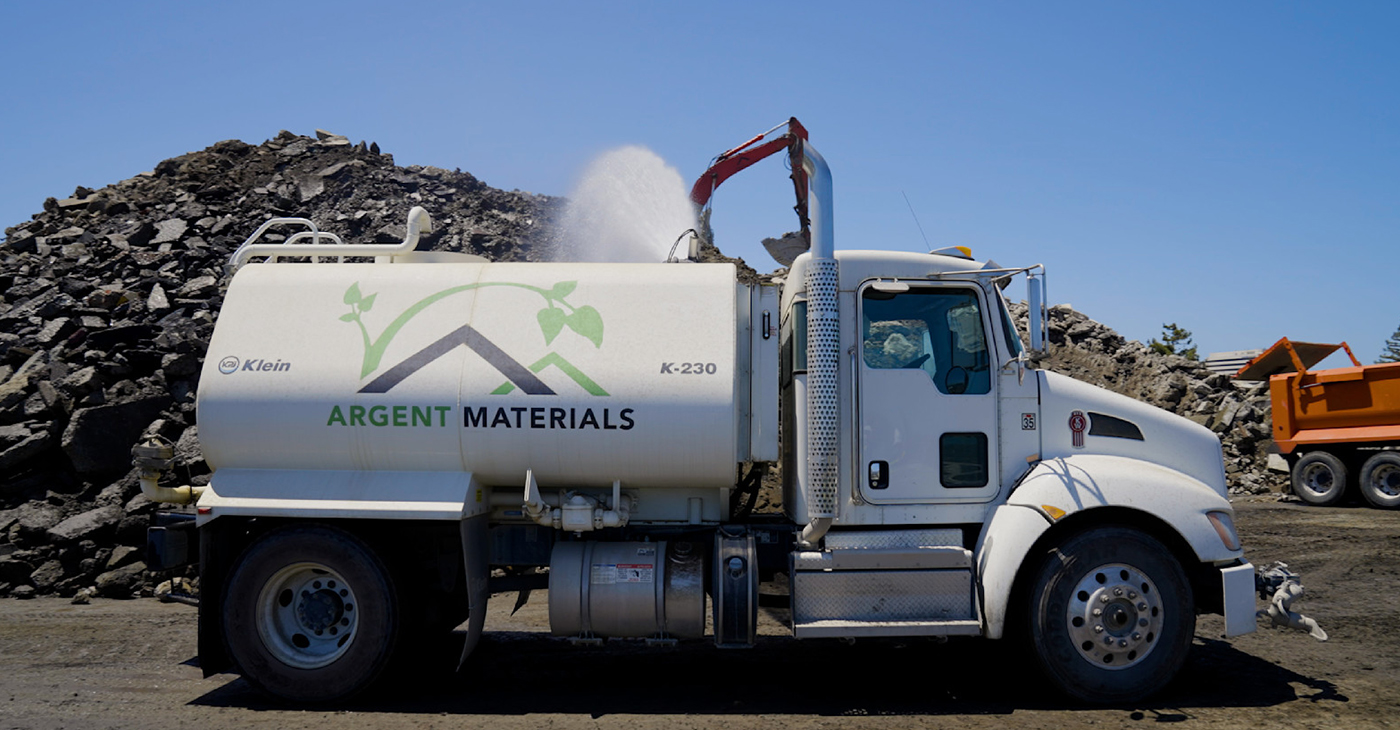
Zennie Abraham
CEO, Zennie62Media
Argent Materials, the Oakland business that turns old concrete and asphalt into new construction products, generally goes by “Argent Materials Oakland CleanTech” but should be called “Argent Materials East Oakland CleanTech for The Community”. Here’s why.
First, Argent Materials is located at 8300 Baldwin St, right in the Coliseum Industrial Zone, just a three-minute drive from the Oakland-Alameda County Coliseum Complex. That’s in East Oakland, and just a city-block walk from the Oakland Coliseum BART Station.
Second, Argent Materials has been a friend to East Oakland and what some, like the members of the Oakland Private Industry Council, would call a “community asset”. In 2024, Argent Materials founder and President Bill Crotinger was named Leader of the Year by the Oakland Private Industry Council (OPIC) “I was humbled and honored to be named Leader of the Year by the Oakland Private Industry Council. Truly an honor. My heartfelt thanks to my friend and mentor Pastor Raymond Lankford and all the wonderful people at OPIC.”
Alameda County Supervisor Lena Tam had this to say about Argent Materials as an Oakland community asset: “Congratulations to Argent Materials and its President and Founder, Bill Crotinger! The company is now fully operational, recycling an impressive 99.99% of concrete and asphalt debris, which helps divert thousands of tons of construction waste from landfills. They are also proud to announce that 50% of their team consists of local hires. In celebration of Thanksgiving, and despite stormy weather last week, the Alameda County Sheriffs, alongside Mr. Crotinger and Argent Materials’ dedicated staff distributed turkeys and pies as a heartfelt gesture of gratitude to the community.”
ABI Foundry reports that Argent Materials led a community clean up for the residents and businesses of Russett Street as well as San Leandro Street. An ABI Foundry team member said “Bill Crotinger at Argent Materials spearheaded the initiative to clean San Leandro street, from Hegenburger to 98th Ave. along the side of BART. AB&I enjoyed participating along with Acts Full Gospel C.O.G.I.C (Men of Valor), Good Hope Missionary Baptist Church-Oakland (Reverend Michael Jones) and Argent Materials. You should see how it looks now. It is AMAZING! It takes an ambitious mind to make a difference block by block.”
What Is Cleantech And Why Is It Important to Oakland And Argent Materials?
Clean technology (Clean Tech) refers to products, services, and processes that mitigate negative environmental impacts by increasing energy efficiency, promoting resource sustainability, and minimizing waste and pollution, ultimately contributing to a low-carbon, and more sustainable economy.
What is The Clean Tech of Argent Materials of Oakland?
In Argent Materials’ context, “cleantech” refers to their sustainable business model which includes recycling concrete and asphalt into new aggregate materials, diverting waste from landfills, and using renewable diesel for their fleet to achieve carbon neutrality and protect the environment. This business approach Argent Materials uses aligns with the broader definition of cleantech, which involves products, services, and processes that reduce negative environmental impacts through resource efficiency and environmental protection
Clean Tech, or green tech as Argent Materials of Oakland does it, is defined as any technology that minimizes negative environmental impact by reducing human consumption of natural resources and by promoting more sustainable and efficient resource use.
Argent Materials will continue to be a cleantech community asset to Oakland well into the future.
Stay tuned.
Activism
Golden State Warriors Program Is Inspiring Next Generation of Female Engineers
Breaking down barriers and biases that deter young girls from pursuing STEAM subjects is essential for creating a level playing field and ensuring equal opportunities for all. By challenging stereotypes and promoting a culture of inclusivity and diversity in STEAM fields, experts believe young girls can be empowered to pursue their interests and aspirations without limitations confidently. Encouraging mentorship, providing access to resources, and celebrating girls’ achievements in STEAM are all crucial steps in creating a supportive environment that fosters success.

By Y’Anad Burrell
The Golden State Warriors and e-commerce giant Rakuten are joining forces to inspire the next generation of female engineers through Building STEAM Futures, part of The City Calls campaign.
Organizers say the initiative is founded on the idea that science, technology, engineering, arts, and mathematics (STEAM) are crucial fields for innovation and progress, and empowering young girls to pursue careers in these areas is more important than ever. Studies consistently show that girls are underrepresented in STEAM fields, resulting in a gender disparity that limits potential and hinders diversity.
Breaking down barriers and biases that deter young girls from pursuing STEAM subjects is essential for creating a level playing field and ensuring equal opportunities for all. By challenging stereotypes and promoting a culture of inclusivity and diversity in STEAM fields, experts believe young girls can be empowered to pursue their interests and aspirations without limitations confidently. Encouraging mentorship, providing access to resources, and celebrating girls’ achievements in STEAM are all crucial steps in creating a supportive environment that fosters success.
On Saturday, March 8, International Women’s Day, the Warriors and Rakuten hosted 20 middle school girls from Girls Inc. of Alameda County at Chase Center’s Above the Rim for a hands-on bridge-building experience. The young girls from Girls, Inc. of Alameda County had an opportunity to design, build and test their own bridge prototypes and learn the fundamentals of bridge construction from the Engineering Alliance and the UC Berkeley Steel Bridge Team.
This STEAM experience for the girls followed the first session in January, where they took a behind-the-scenes tour of the Golden Gate Bridge, learning about its design and construction from industry experts. The City Calls campaign, tipped off with the unveiling the Warriors’ new bridge-themed City Edition jerseys and court design earlier this year.
Activism
Self-eSTEM Empowers BIPOC Women, Girls in Science, Math
In January 2025, Self-eSTEM will launch digital and generative AI programming, which provides digital literacy and AI literacy training through an entrepreneurial project-based activity. This programming will be a hybrid (i.e. in-person and online). Additionally, thanks to a grant from Comcast, in spring 2025, the organization will have a co-ed series for middle and high school students.

By Y’Anad Burrell
Special to The Post
In a world where technology plays an increasingly central role in all aspects of life, the importance of Science, Technology, Engineering, and Math (STEM) education cannot be overstated. Recognizing the significance of STEM for the future, focusing on young women and girls is a critical step in achieving gender equality and empowering the next generation.
Self-eSTEM, an Oakland-based non-profit organization, was founded by Adamaka Ajaelo, an Oakland native who had a successful corporate career with several Bay Area technology and non-tech companies. Ajaelo boldly decided to step away from these companies to give 100% of her time and talent to the non-profit organization she started in 2014 in the belief that she can change the game in innovation and future STEM leaders.
Over the course of a decade, Ajaelo has provided futurist tech programming to more than 2,000 BIPOC women and girls. The organization has an Early STEM Immersion Program for ages 7-17, Emerging Leaders Workshops for ages 18-25 and volunteer network opportunities for ages 25 and up.
In January 2025, Self-eSTEM will launch digital and generative AI programming, which provides digital literacy and AI literacy training through an entrepreneurial project-based activity. This programming will be a hybrid (i.e. in-person and online). Additionally, thanks to a grant from Comcast, in spring 2025, the organization will have a co-ed series for middle and high school students.
While the organization’s programs center on innovation and technology, participants also gain other valuable skills critical for self-development as they prepare for a workforce future. “Self-eSTEM encourages young women to expand on teamwork, communication, creativity, and problem-solving skills. The organization allows young women to enter STEM careers and pathways,” said Trinity Taylor, a seventh-year innovator.
“Our journey over the last decade is a testament to the power of community and opportunity, and I couldn’t be more excited for what the future holds as we continue to break barriers and spark dreams,” said Ajaelo.
“By encouraging girls to explore STEM fields from a young age, we foster their intellectual growth and equip them with the tools needed to thrive in a competitive global economy,” Ajaelo says.
Empowering young girls through STEM education is also a key driver of innovation and progress. When young women and girls are encouraged to pursue careers in STEM, they bring unique perspectives and problem-solving approaches to the table, leading to more diverse and inclusive solutions. This diversity is crucial for driving creativity and pushing boundaries in scientific and technological advancements.
Self-eSTEM has fundraising opportunities year-round, but year-end giving is one of the most critical times to support the program. Visit www.selfestem.org to donate to the organization, as your generosity and support will propel programming support for today’s innovators.
You will also find more details about Self-eSTEM’s programs on their website and social channels @selfestemorg
-

 #NNPA BlackPress4 weeks ago
#NNPA BlackPress4 weeks agoLIHEAP Funds Released After Weeks of Delay as States and the District Rush to Protect Households from the Cold
-

 Alameda County3 weeks ago
Alameda County3 weeks agoSeth Curry Makes Impressive Debut with the Golden State Warriors
-

 Activism4 weeks ago
Activism4 weeks agoOakland Post: Week of November 26 – December 2, 2025
-

 #NNPA BlackPress4 weeks ago
#NNPA BlackPress4 weeks agoSeven Steps to Help Your Child Build Meaningful Connections
-

 #NNPA BlackPress4 weeks ago
#NNPA BlackPress4 weeks agoSeven Steps to Help Your Child Build Meaningful Connections
-

 #NNPA BlackPress4 weeks ago
#NNPA BlackPress4 weeks agoTrinidad and Tobago – Prime Minister Confirms U.S. Marines Working on Tobago Radar System
-

 #NNPA BlackPress4 weeks ago
#NNPA BlackPress4 weeks agoTeens Reject Today’s News as Trump Intensifies His Assault on the Press
-

 #NNPA BlackPress4 weeks ago
#NNPA BlackPress4 weeks agoThanksgiving Celebrated Across the Tri-State

